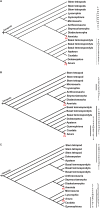Sesamoids in Caudata and Gymnophiona (Lissamphibia): absences and evidence
- PMID: 33384907
- PMCID: PMC7751427
- DOI: 10.7717/peerj.10595
Sesamoids in Caudata and Gymnophiona (Lissamphibia): absences and evidence
Abstract
An integrative definition of sesamoid bones has been recently proposed, highlighting their relationship with tendons and ligaments, their genetic origin, the influence of epigenetic stimuli on their development, and their variable tissue composition. Sesamoid bones occur mainly associated with a large number of mobile joints in vertebrates, most commonly in the postcranium. Here, we present a survey of the distribution pattern of sesamoids in 256 taxa of Caudata and Gymnophiona and 24 taxa of temnospondyls and lepospondyls, based on dissections, high-resolution X-ray computed tomography from digital databases and literature data. These groups have a pivotal role in the interpretation of the evolution of sesamoids in Lissamphibia and tetrapods in general. Our main goals were: (1) to contribute to the knowledge of the comparative anatomy of sesamoids in Lissamphibia; (2) to assess the evolutionary history of selected sesamoids. We formally studied the evolution of the observed sesamoids by optimizing them in the most accepted phylogeny of the group. We identified only three bony or cartilaginous sesamoids in Caudata: the mandibular sesamoid, which is adjacent to the jaw articulation; one located on the mandibular symphysis; and one located in the posterior end of the maxilla. We did not observe any cartilaginous or osseous sesamoid in Gymnophiona. Mapping analyses of the sesamoid dataset of urodeles onto the phylogeny revealed that the very conspicuous sesamoid in the mandibular symphysis of Necturus beyeri and Amphiuma tridactylum is an independent acquisition of these taxa. On the contrary, the sesamoid located between the maxilla and the lower jaw is a new synapomorphy that supports the node of Hydromantes platycephalus and Karsenia coreana. The absence of a mandibular sesamoid is plesiomorphic to Caudata, whereas it is convergent in seven different families. The absence of postcranial sesamoids in salamanders might reveal a paedomorphic pattern that would be visible in their limb joints.
Keywords: Amphibians; Heterotopic elements; Homology; Mandibular sesamoid; Optimization.
© 2020 Ponssa and Abdala.
Conflict of interest statement
Virginia Abdala is an Academic Editor for PeerJ.
Figures







Similar articles
-
Sesamoids in anurans: new data, old issues.Anat Rec (Hoboken). 2010 Oct;293(10):1646-68. doi: 10.1002/ar.21212. Epub 2010 Jul 22. Anat Rec (Hoboken). 2010. PMID: 20652935
-
The Relationship Between Digit Independence and Digital Sesamoids in Humans and a Proposal of a New Digital Sesamoid Evolutionary Hypothesis.Anat Rec (Hoboken). 2018 Jun;301(6):1046-1060. doi: 10.1002/ar.23774. Epub 2018 Jan 31. Anat Rec (Hoboken). 2018. PMID: 29314775
-
How common are cranial sesamoids among squamates?J Morphol. 2017 Oct;278(10):1400-1411. doi: 10.1002/jmor.20719. Epub 2017 Jun 20. J Morphol. 2017. PMID: 28635148
-
Sesamoids in tetrapods: the origin of new skeletal morphologies.Biol Rev Camb Philos Soc. 2019 Dec;94(6):2011-2032. doi: 10.1111/brv.12546. Epub 2019 Jul 29. Biol Rev Camb Philos Soc. 2019. PMID: 31359608 Review.
-
An overview of the osseous palmar sesamoid in Anura, with the particular case of some Rhinella species.PeerJ. 2023 May 15;11:e15063. doi: 10.7717/peerj.15063. eCollection 2023. PeerJ. 2023. PMID: 37214098 Free PMC article. Review.
Cited by
-
A new species of the genus Tylototriton (Urodela, Salamandridae) from western Thailand.Zookeys. 2021 Nov 19;1072:83-105. doi: 10.3897/zookeys.1072.75320. eCollection 2021. Zookeys. 2021. PMID: 34899008 Free PMC article.
-
Phylogenetics of Archerfishes (Toxotidae) and Evolution of the Toxotid Shooting Apparatus.Integr Org Biol. 2022 Mar 21;4(1):obac013. doi: 10.1093/iob/obac013. eCollection 2022. Integr Org Biol. 2022. PMID: 35814192 Free PMC article.
References
-
- Adriaens D, Verraes W. Ontogeny of the osteocranium in the African catfish, Clarias gariepinus Burchell, 1822 (Siluriformes: Clariidae): ossification sequence as a response to functional demands. Journal of Morphology. 1998;235:183–237. doi: 10.1002/(SICI)1097-4687(199803)235:3<183::AID-JMOR2>3.0.CO;2-8. - DOI - PubMed
-
- Agnarsson I, Coddington JA. Quantitative tests of primary homology. Cladistics. 2008;24:51–61. doi: 10.1111/j.1096-0031.2007.00168.x. - DOI
LinkOut - more resources
Full Text Sources

